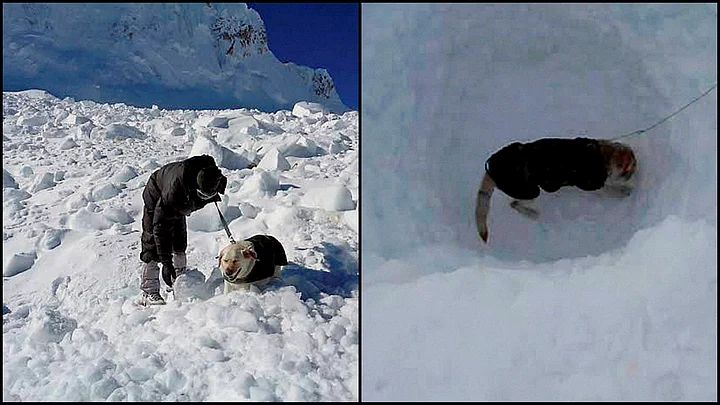Dogged determination of over 150 soldiers helped by two canines, Dot and Misha, besides earth penetrating radars and special ice cutting equipment helped rescue Lance Naik Hanumanthappa Koppad, who was buried under tonnes of ice at 19,500 feet on the Siachen Glacier.
On February 3, an 800x400ft ice wall broke off and covered an army post in the northern glacier in Siachen, the world’s highest battlefield.
The debris, including massive ice boulders, some the size of a small room, spread over 800x1000 metres.
The rescue teams had the arduous task of breaking through 25-30 ft of blue ice, which is harder than concrete, and had to chip it away inch by inch, army officials said explaining the rescue operation.
Over 150 trained and acclimatised army troops, including specialised teams trained in glaciated terrain, were moved to the avalanche site and round-the-clock rescue operations were carried out in extreme weather conditions where average day temperatures were minus 30 degrees celsius and night temperatures below minus 55 degrees.
Medical teams and equipment were moved in and a post established to provide emergency treatment at the rescue site itself. Specialised rescue dogs were also pressed into service.
“The dogs, Dot and Misha, did a tremendous job,” the officials said.
Specialised digging and boring equipment, like rock drills, electrical saws and earth augers were flown in.
In addition, deep penetration radars, capable of detecting metallic objects and heat signatures at a depth of 20 meters, and radio signal detectors were also flown in using Air Force fixed wing aircraft and Army Aviation helicopters.
Using the specialised equipment, the rescue teams were able to identify locations, where digging was carried out.
However, rescue efforts were frequently hampered by high-velocity winds and blizzards. By yesterday, the rescue teams were able to reach the location of the buried habitat and Koppad was recovered alive.
The bodies of nine soldiers were also extricated from their icy grave.
“Him being found alive electrified the entire rescue team. There was a sudden burst of energy among the men,” officials said.
When rescued, Koppad was conscious but drowsy and disoriented. He was severely “dehydrated, hypothermic, hypoxic, hypoglycemic and in shock”.
He was immediately resuscitated by the doctors at the site, who had been there for the past 5 days in the hope of finding a survivor.
He was treated with warm intravenous fluids, humidified warm oxygen and passive external rewarming. He was later moved to the Army Research and Referral Hospital here, they said.
